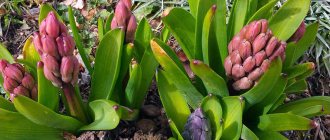Tulips are one of the first flowers that symbolize the arrival of spring. Their dense, elastic leaves are pleasing to the eye against the backdrop of black earth that has just recovered from the cold. Proper planting of tulips in the fall is the key to their early and successful flowering. Don't be afraid of difficulties: growing tulips only seems like a complicated process. In fact, even a novice gardener can cope with this mission. Follow simple rules and recommendations - and your flower garden will attract the admiring glances of neighbors from all over the area.
There are 2 ways to plant bulbs: in spring and in winter. There are more benefits to planting tulips in the fall. This is what will be discussed further.
Digging and storing bulbs
Tulips are dug up every year. Exceptions are baby bulbs, which remain in the ground for 2 years. Why is this needed: diseased specimens are discarded, appearance improves (flowers become larger), and the ability to produce children increases.
There are a number of rules for when and how excavation is carried out:
- Don’t miss the moment: you need to dig up tulips when the leaf is 2/3 dry. If you get the bulb early, it will not have time to accumulate the required supply for subsequent flowering. Late extraction is fraught with the risk that the maternal part will go deeper underground, and the children will separate from it. There is a high probability of missing or damaging planting material.
- Arm yourself with a bayonet shovel: you should stick it deep and with a “margin” around the edges so as not to damage the flowers.
- Change the bed every 3 years.
Cunning
remove the flower stalk after it has finished blooming. This will help the tulip gain strength. And the leaves themselves should not be removed under any circumstances - it is due to them that the necessary substances accumulate.
More examples of the beauty of tulips
Burgundy tulips with white border Source 3agorod.ru
Red flowers with white fringe along the edges Source oir.mobi Sunny flower with scarlet tongues Source mtdata.ru
Unusual black tulips Source intellectyal.ru
Tiger-colored flowers with fringe Source yandex.ru
Lush pale pink flowers Source pinimg.com
Peony-shaped variety of tulips Source mykaleidoscope.ru Lilac shades of tulips with fringe Source domashniecvety.ru
Simple tulips with a beautiful shade of purple Source foto.my.mail.ru
White petals with a pink frame Source goodfon.ru
Beautiful meadow of spring flowers Source zastavki.com
For some, yellow tulips are harbingers of separation, but for others they are just beautiful flowers Source vfl.ru
Lush clouds of fringe on pink petals Source domashniecvety.ru
Almost roses that will decorate the spring garden Source selcdn.fedsp.com Pink tulips in flower beds with blue scillas Source lachat.ru
Tulips in a flowerbed with white pansies Source na-dache.pro
Flowers can be grown in large clay pots Source bezgoroda.com
Purple flowers with shades of white Source fotoload.ru
Tiger and white tulips in one flower bed Source oir.mobi
Such tenderness will decorate the spring garden Source pixabay.com
It’s nice to relax on a bench in the garden next to such beauty Source goodfon.ru
Burgundy flowers with white streaks Source pixabay.com Soft pink peony tulip Source goodfon.ru
Bright carpet of yellow flowers Source etsystatic.com
A delicate meadow of white and pink flowers Source goodfon.ru Pink and burgundy tulips in one large flower bed Source samicebeci.net A small flower bed for garden decoration Source 1zoom.ru
Airy buds of unusual tulips Source oir.mobi Multi-colored flowerbed for a rainbow mood Source sadgrad.ru Pink flowers in the spring garden Source dizainexpert.ru
Marshmallow shades of tulips among blue primroses Source twimg.com
Burgundy garden decoration Source 1zoom.ru
Delicate white tulip heads Source centr-sadovoda.ru Glade of beautiful flowers Source wallhere.com
White and purple tulips Source twimg.com
Decorating a flower bed in the garden Source lykoshko.com
Tulips next to pansies Source wallhere.com
Beautiful design of a flower bed along the fence Source zelendvir.com.ua
Delicate meadow with hyacinths Source lachat.ru Bright multi-colored flower bed Source goodfon.ru
Unusual spring garden decoration Source oir.mobi
Tulips are “friends” with different flowers Source pixabay.com White meadow of delicate flowers Source lachat.ru
White flowers with purple hyacinths Source wallhere.com
Shades of pink flowers Source archidea.com.ua
Purple peony tulips Source rastenia.pro
Choosing a place and preparing a bed
A good location of the bed and planting tulips in the fall, when and how to plant the choice will be less problematic. These flowers love sunny spaces sheltered from the winds. In spring, no puddles should form there. The soil should drain well - the best option would be loamy or sandy loam soil with a significant proportion of humus.
Cunning
asters, watermelons, melons, zucchini, cucumbers, and tomatoes are not the best predecessors for tulips.
It is worth digging up the ground to a depth of 25-30 cm, carefully removing the roots of weeds, trees and shrubs. If the soil is heavy and poor, add sand and fertilizers: compost, ash, peat, mineral complexes. Cow manure should not be used - add bird droppings instead. If the pH values are increased towards oxidation, liming is required.
The soil needs to be prepared a month before the expected planting date. This is necessary for the soil to “settle.” In a loose “cushion” there is a high probability of damaging the emerging roots. Before planting, water the ridges generously - this will completely distribute the soil.
Cunning
Sprinkle the formed rows with a thin layer of sand. This will provide additional drainage and help reduce the likelihood of rotting.
Usually this is where caring for tulips after planting in the fall ends. There is no need to cover the bed - this can lead to the bulb growing ahead of schedule, overwintering worse and blooming later. Exceptions include sudden cold weather. When the temperature drops sharply, use specialized covering material. Do not use garden waste, mulch or leaves as this may attract rodents.
Autumn planting rules
Planting tulips
Planting and caring for tulips in the fall includes several stages. In order for ephemerals (plants with a short growing season) to bloom, it is important to choose a place, a suitable time, and take into account the characteristics of planting.
Alternative methods of planting bulbs are also interesting. Every little detail is important, observing the subtleties of planting. otherwise, full flowering in the spring will remain in question.
Choosing a location and creating a bed
It is important to choose a suitable location and prepare the ground
The land is prepared a month before planting, so choosing a suitable site with good lighting is taken care of in advance. You should not grow ephemerals three times in one place. New, exotic varieties are quite capricious and are easily damaged by pests and diseases that accumulate in the flower beds where tulips are constantly planted.
To grow a flower crop, you must comply with the requirements for growing conditions. Best option:
- sunny and level areas, protected from the wind
- well-drained soils where water does not accumulate in spring
- sandy loams and loams rich in humus
- neutral or alkaline compounds
The area is dug up to a depth of 25-30 cm, and weeds are removed. For better water and gas permeability, peat and (or) coarse sand are added. Add nutrient mixtures that include organic matter: compost and humus, as well as mineral compounds with potassium, nitrogen and phosphorus. They create a fertile layer in which the tulips will be planted.
Double superphosphate
With the onset of warmth, it is useful to add ammonium nitrate, which will help plants grow faster and form green mass. Superphosphate is needed when planting for good root formation. It is also added when the buds appear. He is “responsible” for beautiful flowering.
Ready-made complex fertilizers for bulbous crops have been created. They are applied to the soil according to the instructions on the package. Adequate nutrition has a beneficial effect on tulips: the plants bloom on time, are distinguished by succulent stems and foliage, and bright, colorful buds.
In the first stages of growth and leaf formation, tulips require nitrogen, which is rich in manure. But it cannot be brought in fresh. The concentrated composition causes burns to the roots, and fungal infections also spread.
Landing Features
Disinfection of bulbs before planting
Planting tulips in the fall begins with checking their condition after “summer hibernation.” The bulbs are carefully examined for infection and treated with drugs: copper sulfate, potassium permanganate or phytosporin. The planting material is soaked in one of these solutions an hour before planting.
Processing the bulbs is mandatory in order to destroy bacterial and fungal infections “in the bud”. Sick specimens are carefully discarded.
With the standard approach, if a natural landscape is created (a meadow of tulips), then the planting pattern is as follows: about 20 cm between rows and 10 cm between bulbs. One option is to plant flowers in a checkerboard pattern. To mark and create holes, use a landing cone, which contains measuring divisions.
There are rules for how deep to plant. Planting depth is related to the size of the bulb:
- children are lowered into the holes by 5-10 cm
- bulbs 3 and 2 are deepened to 12 cm
- large specimens of the 1st analysis – up to 15 cm
You need to decide at what depth to plant tulips in the fall, so as not to be disappointed with the results in the spring. If you plant the bulbs deeper, the plant will need more effort to form the above-ground part and flowering will be delayed. Planting tulips in November assumes that the gardener has already thought through the planting scheme and created design options for his flower garden.
Traditional landing option
Small bulbs of ephemerals are planted along the edge, and large ones are given a place in the center. They select the appropriate color scheme, combine varieties according to flowering dates, and come up with interesting combinations with other primroses: hazel grouse, muscari, hyacinths.
Advice from experienced craftsmen will tell novice gardeners how to plant tulips in the fall:
- The bottom is located on the lower part of the bulb. This is the area where the roots form. The bulb should be planted bottom down. If you turn it over, the peduncle will be weak and most likely die
- The bulbs should be placed in pre-prepared planting holes with loose soil. There is no need to forcefully press them into the ground: this will break the weak rudiments of the root system. In addition, the depth of embedment into the soil will be small. Only after planting, the soil is poured on top in a dense layer.
- It is not necessary to water tulips during planting: the moisture from autumn rains is sufficient.
- It is important to mark the planting location so that in the spring, when forming a flower bed and placing other flowers, you do not damage the bulbs. Sometimes they put up beacons with an inscription or cover the location of the tulips with pebbles
It is not necessary to cover the flowerbed with planted bulbs. But this is only if the planting deadlines are met. It happens that winter frosts set in suddenly or planting was carried out late. In this case, they are generously sprinkled with sawdust and covered with spruce branches on top. A special covering material is also used.
Protecting flowers with caps of snow will help lazy gardeners. The shelter will save the bulbs from freezing in the middle zone and the Urals.
Boarding time
Plants planted on time bloom in due time. Flowering time depends on the variety
When asked whether it is possible to plant tulip bulbs in November, some gardeners shrug their shoulders, because planting time depends on a number of factors. The main point to pay attention to is soil temperature. You need to plant tulip bulbs at +8-+10 degrees so that they sleep and gain strength, and life processes in it go slowly. The temperature is measured with a depth thermometer, lowering it 10-12 cm underground.
In the southern regions, the question of whether it is possible to plant tulips in November is not fundamental: the last ten days of autumn is the right time. The further south you go, the later the planting dates are; they move towards winter.
In the Moscow region, the bulbs reach the soil in October. In Siberia, seed is planted for wintering from late September to mid-October. The exception is warm autumn, when the soil is well warmed up. Then flower growers take up their shovels in early November. The tulip needs time for rooting (30-45 days) so that in the spring it actively begins to grow.
It has been proven that the Moon affects the growth and development of plants, so flower growers turn to the lunar calendar for help. Bulbs are planted only on the waning moon. The waxing Moon, Full Moon and New Moon are not suitable for these purposes.
According to the lunar calendar of 2022, the most favorable dates are:
- September 9 and 10
- October 6, 7 and 8
- November 3 and 4
You need to plant healthy and large bulbs to get luxurious flowers
Why is it so important to decide whether you can plant tulips in November? Planted in time, they overwinter and in cold soil undergo a dormant period (stratification period), which is important for lush flowering.
If you plant ephemerals in too warm soil, they begin to grow in the fall, and then the sprouts freeze. In soil that is too cold, the bulb is not able to take root and in the spring the plant develops slowly, delaying flowering. Some varieties overwinter when planted in cold, but not frozen ground (the time of the “first snow”).
If you plant ephemerals in the spring, it will take a long time for rooting, after which the stem will begin to form. But you don’t have to wait for flowering, since the onion must necessarily go through a period of stratification (long exposure to the cold). Spring planting does not provide this opportunity, so only leaves will grow.
If on the eve of planting it is clear that a sprout has appeared on the onion and growth processes have begun, then it is better to save it for spring forcing by planting it in a pot. Having gone through all the stages required for forcing (stratification in the refrigerator), the plant will bloom at the desired time.
How to plant
Treat your tulip bulbs before planting in the fall to protect them from fungal infections. For this purpose, special preparations are produced that can be replaced with ordinary potassium permanganate. Inspect again: healthy and diseased plants cannot be planted together. Affected bulbs must be disposed of.
Planting depth of tulip bulbs
The standard scheme for planting tulips is as follows: rows are made at a distance of 25-30 cm. Their location should fit organically into the perimeter of the flowerbed. The distance between the bulbs is 8-10 cm. Planting depth depends on the size:
- Children: 5-10 cm.
- III and II analysis: 12 cm.
- I analysis: 15 cm.
Keep in mind that small bulbs produce small flowers. To avoid being shaded by taller flowers, plant them at the edge of the flowerbed on the south side. If you like the “uncultivated” look, then there is no need for combination. Create wider spacing between flowers and enjoy the natural state of your garden.
If you are interested in landscape design, then plant tulips according to the pattern. When compiling it, take into account the timing of flowering, the diameter of the inflorescence, and the color of the petals. Think over and sketch in advance the scheme according to which you will plant the bulbs. The picture can be supplemented with other primroses.
Video “Planting tulips in autumn: diagram, depth, planting dates”
How to choose good tulip bulbs
When purchasing planting material in a store, you need to choose only high-quality plants. It is important that they are not affected by diseases or pests. Such bulbs may not sprout and infect neighboring flowers. The tulip root should be firm to the touch. It is better not to purchase planting material in packaging that makes it difficult to see the product. It is difficult to determine a healthy and high-quality onion by seeing it. There should be no cracks or rot on the surface. You also need to discard the dried material, because... it won't rise. The chance of rotting is always higher in cellophane packages. If the bulb has been stored correctly, it will grow well. Therefore, give preference to products that are on an open display or in a large grid. Without air, the plant begins to quickly rot.
Some gardeners purchase tulips in advance, when there is a whole month left before planting. During this period, it is important to properly store the purchased material. If the bulb is in a warm place, it will begin to germinate and will not be suitable for sowing, because The first frosts will damage the seedlings. It is not difficult to protect a tulip from this: just place it in a cool place. A refrigerator or underground space will do.
Tiers and sandwiches: alternative planting methods
A creative approach will make any task interesting. This also applies to floriculture. Recently, unusual methods of planting tulips have been gaining popularity. They save time, decorate the garden and attract attention. In addition, they are quite simple and anyone can master them.
Planting tulips in autumn in containers
Container planting or planting in baskets simplifies the process of growing tulips. The essence of this method is to use baskets, containers and other containers instead of a flower bed or bed. They can either be dug into the ground or freely placed in any convenient place.
Advantages of this method:
- You are firmly confident that you have completely dug out the planting material. The bulbs themselves are minimally damaged and, therefore, are better stored.
- You create optimal conditions for plant growth. Relevant for infertile soils - it’s easier to create ideal conditions in a limited space.
- The likelihood of damage to the bulbs by rodents is reduced. Mice cannot overcome the barrier from below.
You can use anything as a container: plastic bottles, boxes, baskets, pots and even bags. One condition is that you need to make holes to drain excess water. Use a hot knitting needle or other similar object for this. The holes should not be large, otherwise mice will get through them.
Method of planting lasagne tulip bulbs
The second way to arrange flowers in an unusual way is tiered planting. The essence of this method is to lay the bulbs at different depths. The very first layer, starting from the bottom, is occupied by large onions. The higher the level, the smaller the size. To avoid making a mistake and planting one flower on top of another, use long thin sticks. Stick them near the planting site, and remove them after the flowerpot is completely filled. This method of combining is also called “lasagna” - the structure resembles this dish in its layering.
When composing such a composition, it is important to take into account the color, size and shape of the petals. Try to play with contrasts: smooth ones with terry ones, red ones with yellow ones. Groups of flowers united by color will look beautiful. For example, variegated with monochromatic ones: the color of the inclusions should match the monocolor of the petals of the neighboring variety. A group in which tulips are selected according to flowering dates will look impressive.
Cunning
you can combine different flowers. You can add irises, crocuses, lilies, daffodils, hyacinths and other bulbs to tulips.
Video “Methods of planting tulips”
Expert tips for creating tulip beds
You can copy someone else's flowerbed design idea. But even then it may turn out to be unsuccessful if you do not know some of the nuances of its content. It is important not only to plant tulips beautifully, but also to care for them throughout their entire season.
Recommendations on how to create and care for a tulip flower garden:
- Before working in the garden, they first make a sketch - the shape of the front garden or flower bed, the distance between the holes for plants, a plan of where and what flowers will be placed in the flowerbed.
- A calculation sheet must be attached to the drawing - it indicates the number of bulbs, seeds with the terms of growth, flowering, and wilting.
- Bulbs must be sorted by variety, timing and height of growth and flowering.
- Only healthy bulbs are planted.
- As soon as the leaves and stems begin to fade, they are cut off so that the new bulb quickly gains strength for ripening.
- In the spring, as soon as the first leaves appear, the plant is fed with nitrogen mineral fertilizers, and during the ripening of the bulb - with potassium fertilizers.
- If you plant tulips in containers, then it is easy to maintain the aesthetics of the flower garden - plants with yellowed leaves are removed, left to ripen, and others are planted in their place.
- When urgent replanting is required on solid soil, but the leaves and stems have not yet withered, then it is possible to replant the flower along with a lump of earth. The bulb will remain undamaged.
Leaves that have not completely yellowed are still left on the stem so as not to disrupt the process of accumulation of nutrients. It is necessary to wait until the plant wilts. If you dig up the bulbs immediately after flowering or fading, the bulbs will be immature. Poor flowering means that the bulbs have grown too much, and the tulip has been growing in one place for a long time. Then in the fall it is removed from the soil, the bulbs are separated and planted separately.
Tulips in the center of the flowerbed, daisies planted around them Source lachat.ru
When to plant
The timing of planting is affected by soil temperature. In the fall, the groundwork is made for subsequent flowering, so it is important to plant the bulbs in the garden on time. For all processes to start, the soil must be no colder than 10° (the lower limit is 8°). You can check the data using a depth thermometer.
In different regions, the timing of planting in open ground is different. Thus, planting tulips in the fall in the Moscow region occurs from mid-September and throughout October. The hotter the region, the closer to winter the dates shift. If, during a pre-planting inspection, you notice that the bulb is ready to actively begin to grow, it makes sense to leave it for forcing (that is, plant it in a pot and keep it at home).
In other regions, which are characterized by more severe climatic conditions, the planting period is from the end of September to mid-October. If the autumn is hot, then they are planted until the beginning of November. For example, the optimal planting of tulips in autumn in Siberia falls on the 10th-20th of October.
Is it possible to plant tulips in spring? Planting tulips in the ground in spring
Tulips are representatives of spring and the earliest flowers that fill store shelves on the eve of March 8th. When the last snow melts from the ground, these plants begin to appear and gradually grow, so that they will soon smell beautiful and delicate buds. If you decide to plant them in your flower garden, then the first question that arises in your mind is: “Is it possible to plant tulips in the spring and how to do it?”
Should you plant tulips in spring?
Of course, for many it is more logical to plant bulbs in the spring, when other plants and vegetable crops are being planted. However, this would be wrong. Experienced gardeners say that the best time to plant bulbs is autumn. This is the best time. Although planting in the spring is not excluded. So, is it possible to plant tulips in the spring? Yes, you can give a bunch of reasons why it is better to place bulbs in open ground at this time of year. Let's figure out whether tulips are planted in the spring.
Nature will give the right answer
To answer this question correctly, it is worth observing how tulips grow in nature. Once you understand the natural rhythm of wildflowers, you can easily determine the ideal time to sow your bulbs.
The birthplace of most varieties of tulips is Central Asia. As a rule, these plants are found here in sandy and rocky deserts, in steppes, rock crevices, on scree, in arid mountain areas and foothills. It is worth noting that in early spring these areas simply amaze with their unique beauty. After all, it is at this time that tulips bloom. The photo confirms this. Flowers cover the deserts and slopes of the mountains of Central Asia with a colorful living carpet.
When the coolness of spring turns into summer heat, the tulips wither and dry out. The entire life of these plants is concentrated in the bulb. Tulips go deeper into the ground. When autumn comes with its coolness, the plant forms new roots. This will allow it to bloom in the spring immediately after awakening. As you can see, in their natural environment, tulips bloom only after winter. The plant needs cold to collect useful components in the bulb, which have a great influence on processes such as germination and flowering. Do you think it is possible to plant tulips in spring? Or should I wait until autumn?
How to determine the time of planting tulips?
If you decide to plant tulips in the spring, then you should consider some rules. First of all, it is necessary to determine the optimal time for disembarkation. First of all, pay attention to the soil temperature. At a depth of 10 centimeters it should be from +7 to +9°C. If the temperature is lower, then planting tulips in the ground in the spring is shaded. The plant simply won't survive.
If you plant flowers in the fall, the soil temperature should be the same. If it is higher, the tulips will sprout. At the first frost, new shoots will die. If the temperature is lower, the plant simply will not have time to take strong roots. As a result, in the spring the plant will be very stunted in growth, and during the flowering period its buds will be small and unattractive.
It takes 20 to 30 days for the tulips to take root. In this case, there should be optimal air humidity. If in the fall the recommended dates were simply missed, then the bulbs can be planted until the first days of December. To prevent the plant from freezing over the winter, the flowerbed should be covered with straw, dry leaves or spruce branches. According to experienced gardeners, planting tulips in the ground in spring is not advisable.
Planting in spring: features
So, is it possible to plant tulips in the spring? Many people claim that it is possible, but it is not worth doing. What to do if all the autumn planting dates have passed, but the bulbs need to be planted? Of course, plants planted in the spring also grow and bloom. They bloom, however, a little later. You can speed up the growth and opening of buds by resorting to simple techniques. Of course, proper care also matters.
Before planting tulips that have lain all winter or were recently purchased, place the tubers in the refrigerator overnight, but not in the freezer.
The next day, dilute a pink solution of potassium permanganate and carefully rinse the bulbs. Only after this can you plant tulips.
Optimal time for disembarkation
In addition to preparing the bulbs, you need to know when to plant tulips in the spring. The best time is until April. If there may still be frost in your area at this time, then plant the bulbs in a container that is suitable in size. When the weather gets warmer, you can move the plants outdoors.
At the same time, remember that agricultural technology when planting must be fully observed. If the care is incorrect, the tulips will practically stop blooming, and their bulbs will be crushed. As a result, the plant will become weak and small.
How to plant tulips correctly: preparing the bed
So, we plant tulips in the spring. First of all, you need to prepare the area for planting the bulbs. You can start preparing the bed for tulips as soon as the snow melts, and the soil will not get so dirty.
If the bed was prepared in the fall and there are no perennial weeds on it, then you don’t have to dig up the soil. Just loosen it to a depth of 5 centimeters. This can be done using a regular hoe or a Fokin flat cutter. After this, make holes or grooves in the soil.
If the bed is still overgrown, then dig it up. At the same time, try to select the roots of perennial grasses as carefully as possible. If the bed was prepared in early spring, and you decided to plant it a little later, and it is overgrown with small weeds, then it is no longer worth digging up the soil. Just loosen the soil.
Planting bulbs
Who doesn’t love beautiful tulips, the photos of which are simply amazing? In order for plants to grow large and bloom well, they must be planted correctly. You can plant bulbs in both early and late spring.
When planting, remember that the soil in spring is very dry, and tulips require a significant amount of moisture. Water the prepared grooves or holes generously with water. Since planting tulips in dry soil in the spring is equivalent to simply throwing them away.
Plant the plant bulbs in the soil and gently cover them with soil. The layer thickness should be from 5 to 10 centimeters. After the plants are planted, you don’t have to water them until the first shoots. After germination, tulips require care.
Loosening the soil
Tulips themselves are unpretentious plants. Growing them is not fraught with great difficulties. However, these flowers require your attention. You need to care for tulips carefully. If you don't give the flower what it needs in time, it will wither and shred. And if the bulb is not properly cared for, it simply will not ripen.
When the first shoots appear, do not loosen the soil, as you can cause severe harm to young plants. It’s better to wait until all the tulips have sprouted and taken root well.
If the soil is dry, water the sprouts generously before loosening it. Everything needs to be done carefully. Start loosening the soil after the moisture has been completely absorbed.
Top dressing
By watering the young shoots, you can also feed them. To do this, you can use a weak solution of mullein, previously diluted in water with humus. Before loosening the bed, sprinkle the soil with a special preparation that contains microorganisms beneficial to tulips. With this product you will not only feed young plants, but also improve the condition of the soil.
You can also add a small amount of regular live baker's yeast. They can also speed up plant growth and improve soil. When feeding these plants, mineral fertilizers, for example, urea, are often used. However, you should not get carried away with such substances, since the effect of their use is short-term. In this case, the development of microorganisms beneficial to the soil is suppressed. Because of this, the bulb will not fully ripen and will be stored very poorly. Organic fertilizers are considered the safest and most beneficial for tulips.
Finally
Tulips are not the most demanding plants. However, you also need to be able to care for them. Caring for the plant should begin with planting the bulbs. And it doesn’t matter at all whether tulips are planted in spring or autumn. It is much more important to create optimal conditions for the growth and development of the bulb. With proper and careful care, plants bloom with large buds, delighting with their beauty and uniqueness. The main thing is to remember that varietal tulips are no different from wild ones.
fb.ru











